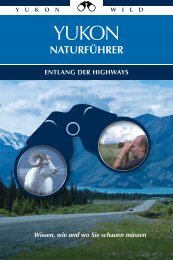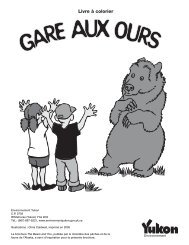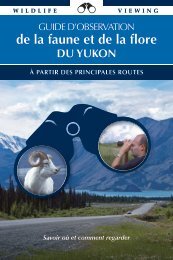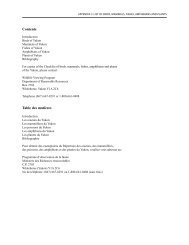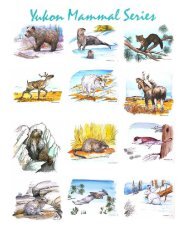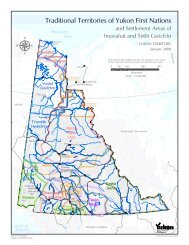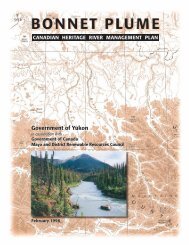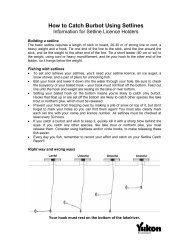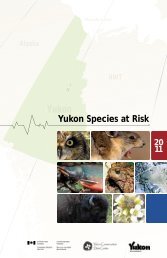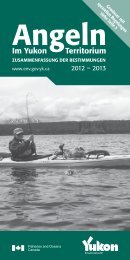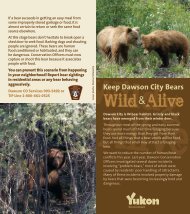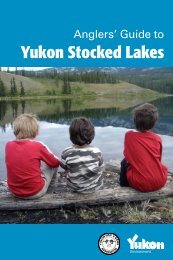Ch. 3 Land - Environment Yukon
Ch. 3 Land - Environment Yukon
Ch. 3 Land - Environment Yukon
Create successful ePaper yourself
Turn your PDF publications into a flip-book with our unique Google optimized e-Paper software.
PROGRESS & CHALLENGES<br />
Since the 1995 State of the<br />
<strong>Environment</strong> report was published,<br />
many significant steps have been taken<br />
to control and regulate solid waste and<br />
contaminants in the <strong>Yukon</strong>. Some of<br />
the achievements in different areas are<br />
listed below:<br />
Progress since 1995<br />
City of Whitehorse 1998 Solid Waste<br />
Action Plan<br />
■ Tipping fees<br />
■ Waste Watch<br />
DIAND Waste Management Program<br />
■ About half of the 800+ waste<br />
management sites have been<br />
cleaned up<br />
<strong>Yukon</strong> <strong>Environment</strong> Act Regulations:<br />
■ Beverage Container Regulation<br />
– amended in 1996 and 1998<br />
■ Contaminated Sites Regulations<br />
– January 1997<br />
■ Storage Tanks Regulations<br />
– January 1997<br />
■ Spills Regulations –1997<br />
■ Solid Waste Regulations – 2000<br />
On-site clean-up:<br />
■ Carcross waterfront<br />
■ Whitehorse fire-training area<br />
■ Whitehorse tank farm<br />
<strong>Ch</strong>allenges:<br />
While many sites could be listed as<br />
problem areas in need of attention, some<br />
of the more significant sites currently<br />
being assessed for clean-up are:<br />
■ Marwell tar pit;<br />
■ War Eagle oil pond at<br />
Whitehorse landfill; and<br />
■ DEW Line sites<br />
Attitudes – If all <strong>Yukon</strong>ers live by the<br />
four Rs of waste reduction, and reduce,<br />
reuse, reclaim and recycle as a way of<br />
life, we will significantly reduce the<br />
amount of waste that we generate.<br />
3.6 Agriculture<br />
Agriculture has been part of the <strong>Yukon</strong><br />
economy since the beginning of nonnative<br />
settlement in the mid-19th<br />
century. Cultivated crops were grown<br />
adjacent to fur trading posts, and the<br />
territory met most of its own<br />
requirements for vegetables and forage<br />
crops during the Gold Rush when most<br />
of the <strong>Yukon</strong>’s 40,000 residents lived in<br />
Dawson City. During the 1920s, prior<br />
to improvements in the transportation<br />
network, extensive local gardens and<br />
farms in communities such as Mayo,<br />
Dawson, Carcross and at the mouth<br />
of the Pelly River provided vegetables,<br />
grain and hay for local markets. A very<br />
limited amount of agricultural<br />
production continued through to the<br />
1960s and 1970s.<br />
Since the <strong>Yukon</strong> agricultural land<br />
allocation program was adopted in<br />
1981, farming has increased (Figure<br />
3.20). Locally grown farm products are<br />
again available in the <strong>Yukon</strong>. In 1991<br />
the sale of livestock and animal products<br />
accounted for half of annual farm<br />
production. Between 1986 and 1996,<br />
the land in crops, number of farms, as<br />
well as on-farm investment and infrastructure<br />
have increased. Steady growth<br />
in the numbers of domestic stock,<br />
broiler chickens, laying hens, turkeys,<br />
grain crops, green feed, forage crops<br />
and greenhouse vegetable production<br />
have contributed to the overall growth<br />
in the industry.<br />
The significant increase in sales of farm<br />
products reflects the allocation of<br />
agricultural land through the <strong>Yukon</strong><br />
government agricultural land programs<br />
(Figure 3.21). Beginning in 1981,<br />
individuals with a minimum of one year<br />
residency in the <strong>Yukon</strong> could apply for<br />
up to eight 65 hectare parcels for a<br />
total of 520 hectares (1,300 acres). As<br />
a result, land dispositions were high at<br />
the beginning of the program. In 1983<br />
alone, there were 28 agricultural land<br />
dispositions for a total of 2,800<br />
hectares. Between the years 1983 and<br />
1991, a total of 6000 hectares of land<br />
were disposed of for agriculture.<br />
While the availability of farmland in<br />
the 1980s boosted the production of<br />
farm products, some dispositions<br />
Figure 3.20 Growth of Agriculture in the <strong>Yukon</strong> from 1956-1996<br />
From 1956 to 1996, the number of farms increased from 16 to 160; the total land in crops<br />
increased from 204 to 5,678 hectares, and the sale of agricultural products rose from<br />
$15,610 in 1961 to $3,536,098 in 1996. There were no data for 1976 and 1981.<br />
C H A P T E R 3 L A N D ❧ 6 1





